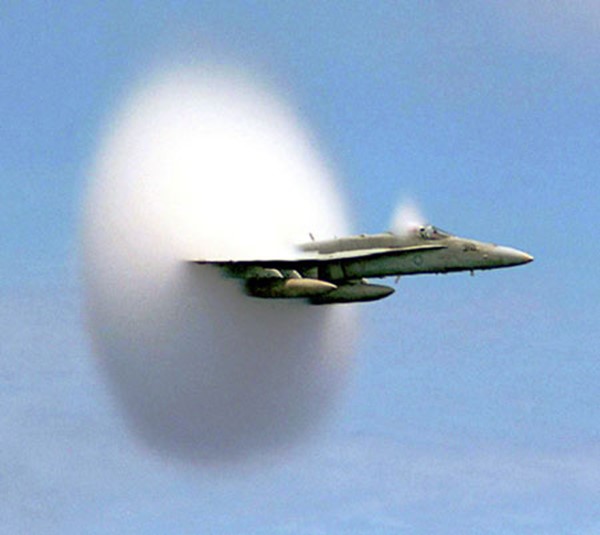Negative impacts of negative pressure
 Vapor shield generated as a plane breaks the sound barrier – the sudden drop in pressure at that boundary invokes a condensation cloud.
Vapor shield generated as a plane breaks the sound barrier – the sudden drop in pressure at that boundary invokes a condensation cloud.
In determining what distinguishes the differences between humans and other animals, many of our human ‘distinguishing’ skills and attributes have been shot down. Tool use, symbolic language, concept of time and consequences, morality, forgiveness, arguably even writing (dogs peeing on fire hydrants, for example) are all represented in the animal world. If there is one thing that really stands out, it is that humans are the only animals not afraid of vacuum cleaners.
And why would this be? Unlike other animals, they don’t scare us because we humans know what vacuum cleaners are supposed to do. But as negative pressure gradients of that magnitude don’t exist in nature, they spook animals that don’t.
So I suppose this is another distinction differentiating humans from other animals – we can create vacuums. (I’ll just leave it at that, without editorializing…).
So how does this play into our conservation discussion?
When the biological impacts of marine pile-driving first came up, it was around the seismic retrofit of the San Francisco Bay Richmond Bridge, between Richmond and San Rafael. When workers noticed that seagulls began feeding furiously on dead fishes off the bay surface when the pile driving commenced, they realized they had a problem.
Out of concern, CalTrans funded a study on pile driving impacts when they did a seismic retrofit on the Bay Bridge, (stretching between Oakland and San Francisco). Using caged fishes in calibrated proximity to the pile driving operations, they dissected the exposed fishes to determine the impacts or cause of death.
The histologies in this study were driven by the assumption that the positive impulse of the pile-driving was the damaging variable, so the results were a bit ambiguous. Later it was found that the positive pressure flux was not as problematic. It was the negative pressure flux that occurred as the noise impulse contracted that induced negative barotrauma.
Animals are built to withstand positive pressure variations – migrating up and down the marine water column, or being pressed by the swells of a tempestuous sea. Their habitat is infused with positive pressure fluctuations. But no organism is adapted to rapid negative pressure impulses because these don’t exist in nature, so when they do occur, they do a lot of damage.
Seismic airguns used in offshore oil surveys are a good example of introducing a rapid pressure expansion followed by and even more rapid pressure contraction. After a paper by Rob McCauley seemed to indicate high zooplankton mortality in proximity to airgun surveys, we figured that negative barotrauma might be the mechanism. We tried to establish this in our Cook Inlet Zooplankton Project, but we were unsuccessful due to a lot of complicating variables (such is science…). But the fact remains that positive pressure impulses – followed by rapid negative contractions, are rarely found in nature, and thus potentially damaging to animal’s bodies and sense organs.
So drifting back to a recent newsletter; anthropogenic generation of negative barotrauma impulses maybe have an outsized impact on wildlife adaptations to their environments. These negative pressure fields are generated by a number of human activities aside from vacuum cleaners. Sonic booms, and vortex shedding off wind turbine blades being among them.
This punctuates a problem we have always had with the noise exposure guidelines advanced by the regulatory agencies: They regulate around noise exposure levels, but not on how pernicious that noise might be. We’ve been vamping on “Kurtosis” for years – a metric correlated with how nasty a noise sounds. Perhaps we need to start looking at positive as well as negative pressure acceleration?
The acoustical compliance of a body and hearing organs cuts both ways, but most of us are built to handle compression. Decompression may be another matter.
Fortunately for us, vacuum cleaners are not large enough to pose a threat.

